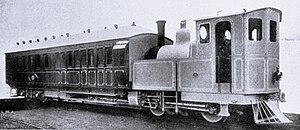0-4-0+4
 Front of locomotive at left | |||||||||||||
 Cape Government Railways Railmotor | |||||||||||||
| |||||||||||||
| |||||||||||||
Under the Whyte notation for the classification of steam locomotives, 0-4-0+4 represents the wheel arrangement of no leading wheels, four powered and coupled driving wheels on two axles and four trailing wheels on two axles mounted in a bogie.
Overview
[edit]The 0-4-0+4 wheel arrangement was usually found on railmotors, vehicles for passenger carrying that operated on routes where passenger numbers were light. It usually consisted of a single coach with its own prime mover. William Bridges Adams in the United Kingdom began building railmotors in small numbers as early as 1848.
Usage
[edit]Cape of Good Hope
[edit]A single Railmotor was delivered to the Cape Government Railways (CGR) in 1906. The railmotor was a self-contained motor-coach in which the locomotive and coach were embodied in a single vehicle, with a driver's station at the rear end of the coach for reverse running. The locomotive part was a 0-4-0 side-tank engine which was built by North British Locomotive Company, while the coach part on a single bogie was built by Metropolitan Amalgamated Railway Carriage & Wagon.[1][2]
Transvaal Colony
[edit]In 1907, the Central South African Railways (CSAR) acquired a single self-contained railmotor for the low-volume railmotor passenger service which had been introduced the previous year. It was a self-contained motor-coach with a 56-seat capacity in which the engine, boiler and coach were embodied in a single vehicle. While the engine part of the vehicle was built by Kitson & Co, the 46 feet 11 inches (14,300 millimetres) long coach part was constructed by Metropolitan Amalgamated Railway Carriage & Wagon. To negotiate curves and points, the power unit could pivot like a bogie. The railmotor was erected at the Salt River shops of the CGR in Cape Town and entered service on the CSAR on 10 August 1907.[3][4][5]
References
[edit]- ^ "South African Railways". Locomotive, Railway Carriage & Wagon Review. Locomotive Publishing Company. 1906-07-14. p. 120.
- ^ Ostendorf, Rolf (1977). Dampftriebwagen, Bauarten, Typen und Systeme (in German). Motorbuchverlag, Stuttgart. pp. 134–135. ISBN 3-87943-517-0.
- ^ Espitalier, T.J.; Day, W.A.J. (1945). The Locomotive in South Africa - A Brief History of Railway Development. Chapter VI - Imperial Military Railways and C.S.A.R. (Continued). South African Railways and Harbours Magazine, March 1945. pp. 184-185.
- ^ CSAR General Manager's Reports, Extracts from the CSAR General Manager's Reports for 1906, 1907, 1908 & 1909.
- ^ Paxton, Leith; Bourne, David (1985). Locomotives of the South African Railways (1st ed.). Cape Town: Struik. p. 24. ISBN 0869772112.
| Single engine types |
|
|---|---|
| Divided drive and Duplex engine types | |
| Articulated locomotives Fairlie, Meyer and Garratt types | |
| Articulated locomotives Mallet types | |
| Articulated locomotives Triplex and other Multiplex types | |
| Articulated locomotives Engerth types | |
| Geared locomotives | |
Text is available under the CC BY-SA 4.0 license; additional terms may apply.
Images, videos and audio are available under their respective licenses.
